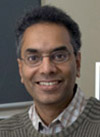Computer Science Professors Work on Federal "Smart Turbine" Wind Energy Project
04-25-2012



Computer Science professors Jan Vitek, Ananth Grama, and Suresh Jagannathan, along with Mechanical Engineering professor Douglas Adams, have received a three-year grant from the NSF Division of Computer and Network Systems. Purdue University News Service recently covered their research in "Purdue scientists, engineers team up on $1.6 million federal 'smart turbine' wind energy project" - which is reprinted below.
WEST LAFAYETTE, Ind. - A team of Purdue University researchers will use a $1.6 million federal grant to advance sensor technology and computer simulation tools for tracking and improving the performance and reliability of "smart" wind turbines and wind farms.
Computer science professors Jan Vitek, Ananth Grama and Suresh Jagannathan, and mechanical engineering professor Douglas Adams received the three-year grant from the National Science Foundation's Division of Computer and Network Systems (CNS).
The team's goal is to increase the performance of wind turbines by reducing downtime, improving the predictability of maintenance and enhancing the safety in operational environments.
"Improvements in the productivity and longevity of wind energy -- the fastest growing source of clean, renewable domestically produced energy -- even by a few percentage points will have significant impact on the overall energy landscape and decision making," said Vitek, the project's principal investigator. "Mitigating failures and enhancing safety will go a long way toward shaping popular perceptions of wind farms and accelerating broader acceptance within local communities."
The project builds on years of research by Adams, who is developing "smart" turbine blades that use sensors and computational software to improve energy capture by adjusting for changing wind conditions. Adams developed these sensing techniques working with Sandia National Laboratories.
Sensor data in a smart system also could be used to better control turbine reliability by automatically adjusting the blade pitch and rotor yaw to reduce damaging operating conditions while also commanding the generator to take corrective steps.
Adams, the Kenninger Professor of Renewable Energy and Power Systems, said no high-tech tools currently exist for tracking and analyzing the coordinated behavior of wind farms. This project will marry those technological advances with a robust computer simulation network, emphasizing programmability, robustness, longevity and assurance of integrated wind farms.
But all of these new capabilities rely on accurate measurements. "It's like the adage: 'If you measure it, then you can control it,' " he said.
A wind turbine's major components include rotor blades, a gearbox and generator. The wind turbine blades are made primarily of fiberglass and balsa wood, and researchers now are strengthening them with carbon fiber.
As the wind turbine blade is being manufactured, engineers can embed sensors called uniaxial and triaxial accelerometers. Research findings show that using a trio of sensors and "estimator model" software reveals how much force is being exerted on the blades.
The Purdue system, which has received support from Purdue's Energy Center in Discovery Park, may help improve wind turbine reliability by providing critical real-time information to the control system to prevent catastrophic wind turbine damage from high winds or other weather event.
Such sensors also might be instrumental in future turbine blades that have "control surfaces" and simple flaps like those on an airplane's wings to change the aerodynamic characteristics of the blades for better control. Because these flaps would be changed in real time to respond to changing winds, constant sensor data would be critical.
"We believe we can have a huge impact by essentially taking small steps to control how these wind turbines operate," Adams said. "For example, a 2-degree error in the pitch of a single turbine blade can cause a 12 percent reduction in power."
Grama said the scale and complexity of these wind power systems pose a challenge for computer scientists. Turbines in a typical wind farm would require as many as 3,000 sensors, all generating real-time data that must be captured and analyzed.
"It's a tremendously sophisticated problem, requiring a comprehensive computational infrastructure for distributed real-time control," Grama said. "Given the relative infancy of 'smart' wind farms, however, the potential of the project cannot be overstated."
Indiana, which has gone from no turbines to more than 1,100 in three years, ranks as the third fastest-growing state for wind power in the country, the American Wind Energy Association reports. The association places Indiana 13th for most installed wind power capacity in the country.
Writers:
- Phillip Fiorini, 765-496-3133, pfiorini@purdue.edu
- Emil Venere, 765-494-4709, venere@purdue.edu